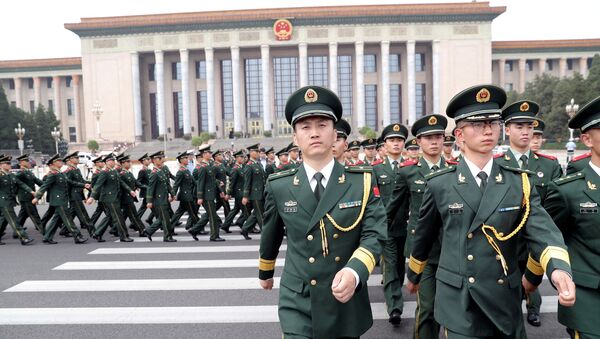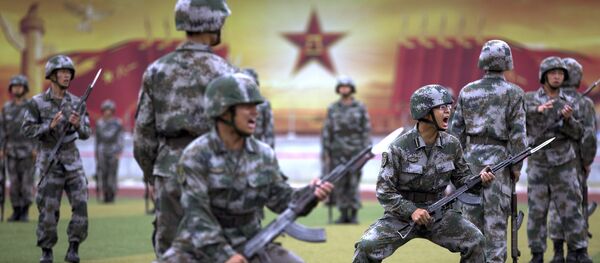During the parade, Chinese President Xi Jinping said that his country needed the strong army more than ever before, according to media reports.
Despite the fact that Xi in 2015 announced his intention to reduce the number of China's military personnel by 300,000, the over 2-million-strong PLA still remains the world's largest military force.
Parade Show of Force
During Monday's parade, the Chinese leadership displayed the most advanced military hardware at its disposal, including Type 99A main battle tanks, HJ-10 anti-tank missile systems, Shenyang J-16 strike fighters and Chengdu J-20 fifth-generation stealth fighter aircraft.
Newest #Chinese tank Type 99A pic.twitter.com/fJ5gJvVTZi
— Babay (@Truth_Seeker_11) 18 сентября 2014 г.
Beijing also presented its "carrier killer" – the DF-21D anti-ship medium range ballistic missile – and unveiled the new DF-31AG intercontinental ballistic missile, which has a maximum range of over 10,000 kilometers.

The state-run news agency Xinhua reported that "it was the first time China has marked Army Day, which formally falls on August 1, with a military parade since the Communist revolution in 1949."
Speaking at the parade, Chinese President Xi Jinping said that the PLA "is able to defeat any aggressor, and is determined to defend national sovereignty, security and the interests of the country."
China Test Fires Long Range Hypersonic Missile From J-16 Fighter Jet https://t.co/Rm95ScFKmv pic.twitter.com/EP16PXdYUZ
— World Of Weapon (@worldofweapon) 25 ноября 2016 г.
At the same time, the Chinese leader stressed that the PLA's main responsibility is to ensure that ordinary people can live in peace.
Macau-based military expert Anthony Wong Dong told the South China Morning Post that "in the face of ongoing crises in the South China Sea and on the Korean Peninsula…the parade certainly became the show of China's military power."
History of the PLA
The PLA was founded on August 1, 1927, during the Nanchang uprising against the then-ruling Kuomintang party. The later civil war resulted in founding the People's Republic of China in mainland China on October 1, 1949.
In this connection, on February 1, 2016, the PLA's structure was changed and its seven military districts were transformed into North, South, West, East and Central military command zones. All of these zones are under the command of the Central Military Commission, which is chaired by the Chinese President.
Another major restructuring of the PLA took place on January 11, 2016 which saw the establishment of the PLA Joint headquarters, due to be subordinate to the Central Military Council.
Chinese Army Undergoing Huge “Reform” https://t.co/FUI2pDoE12 pic.twitter.com/zFRkoiTcA4
— I Razor I (@I__Razor__I) 20 апреля 2017 г.
The start of military reforms was followed by the creation of missile and strategic forces within the PLA. At present, these forces, along with the land, air and naval forces as well as the People's Armed Police constitute the Chinese armed forces.
President #XiJinping calls for military reform to build strong Chinese army, ahead of next week's Army Day pic.twitter.com/pMLetWa0y0
— CGTN (@CGTNOfficial) 27 июля 2016 г.
China's military spending is constantly on the increase and the country's defense budget is the world's second-largest after that of the US, according to media reports.
That could bump China's total military spending could approach $500 billion, according to some estimates. https://t.co/G7uOCOxcvW
— NBC Nightly News (@NBCNightlyNews) 29 июня 2017 г.
China's military budget in 2017 amounts to 1.3 percent of the country's GDP or 151.97 billion dollars. For comparison's sake, Washington has insisted that its NATO allies increase military spending to 2.0 percent of GDP, and the US itself spends over 600 billion dollars annually on defense.
En Route to Remote Shores
Right now, China is expanding its global military clout, which was something that became evident after a group of ships of the PLA's Navy left for Djibouti in July 2017 to build a logistics base near the Horn of Africa. The facility will be Beijing's first foreign military base.
Another look at China's new military base in Djiboutihttps://t.co/7l2mnGTJGJ
— rhk111 Defense (@PhilDefNews) 31 июля 2017 г.
The Chinese Defense Ministry has repeatedly noted that the base will be used for peacekeeping operations, fighting piracy and delivering humanitarian aid. As the world's largest exporter of manufactured goods, China hopes to ensure the safety and reliability of nearby shipping lanes.
China's military base in Djibouti appears to have major underground fortifications https://t.co/tGEF6ITiiL via @LibertyUnyieldi pic.twitter.com/tr4hs4Tl29
— Michael Dorstewitz (@MikeBPR) 27 июля 2017 г.
Since 1990, China has also actively participated in UN peacekeeping missions. In 2012, about 2,000 Chinese military servicemen were involved in such missions, mainly in Africa.






